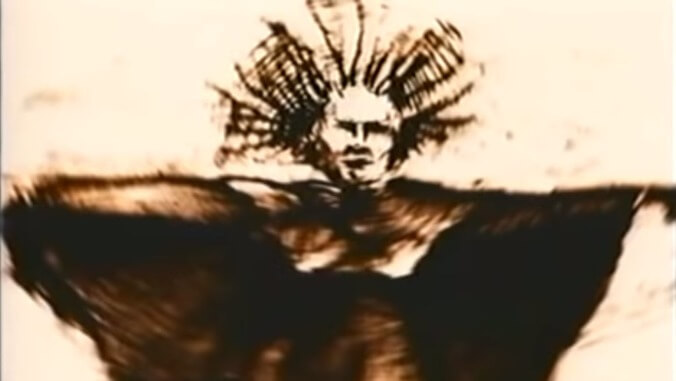Before The Blair Witch Project hit theaters, a TV special reinforced its ingenious deception


Schlock-doc cable television reached its highest (or maybe lowest) point in the late ’90s. During that era, random channel-surfing could almost always turn up a grimy true-crime exposé, history of American UFO sightings, or countdown of the most haunted hotels in America thanks to shows like Ripley’s Believe It Or Not, Forensic Files, and History’s Mysteries. So prevalent were these offerings that few batted an eye when Syfy (then the Sci-Fi Channel) got in on the craze, premiering an hour-long special entitled Curse Of The Blair Witch on July 11, 1999.
Curse possessed the prerequisite schlock-doc hallmarks: Ken Burns-esque pans across archival images, interviews with various oddball talking heads, ominous synth music and low-rent reenactments, all detailing a small Maryland town’s history of unexplained tragedies since its late-18th-century founding, purportedly due to a malignant witch’s ghost haunting the nearby forests. The legend allegedly received renewed interest in recent years after three college film students entered the woods outside Burkittsville to film their own documentary, never to emerge.
Audiences were intrigued, especially after the documentary’s conclusion teased some of the missing students’ terrifying footage could be seen later that month in movie theaters. The story’s biggest shock, of course, was something else entirely: Both the upcoming feature-length mockumentary and the TV special hawking it were entirely fictitious—Curse Of The Blair Witch was nothing more than an ingenious promotional tool to drum up interest in what would become one of the most profitable and divisive horror films of all time, The Blair Witch Project, which turns 20 this week.
“The fact that something I wrote was on Sci-Fi Channel at at all was insanely exciting to me,” Ben Rock recounted to The A.V. Club over the phone last month. Rock was responsible for creating Curse Of The Blair Witch, as well as much of the initial Blair Witch lore, including the iconic “Stick Man” figure he designed while working on the movie’s legitimately bonkers guerrilla filming process. “It was the most pleasant surprise of my entire life.” Mike Monello, co-producer of both Curse and the feature film, added in a separate phone interview: “I think it was one of the highest-viewed originals on Sci-Fi… the ratings were so good.”
Curse Of The Blair Witch became a Sci-Fi staple throughout the summer, dousing kerosene on the hype smoldering within the genre scene ever since The Blair Witch Project debuted at the Sundance Film Festival back in January. A few months before the festival premiere, Bravo’s indie filmmaker spotlight show, Split Screen, debuted seven minutes of test footage from directors Eduardo Sanchez and Daniel Myrick, prompting viewers to flock onto a nascent internet to discuss what they saw. Each re-airing brought more people to Split Screen’s message boards, dominating the site to the eventual annoyance of the show’s other featured indie hopefuls. Both Rock and Monello remember Bravo all but begging Sanchez and Myrick to make their own website to siphon fans of their movie, still technically unfinished and definitely not yet sold.
In the months after Split Screen, Sanchez and Myrick enlisted a handful of friends, including Rock and Monello, to curate an official Blair Witch website. It included a complete historical lore timeline from Rock, interviews with surviving family members and investigators played by local actors, and its own extremely active message board filled by a growing legion of diehard fans driven to the site from Split Screen reruns and word of mouth. “People love to be scared, and the only thing they love more than being scared, I think, is scaring other people. And so it took on a life of its own and eventually got away from us,” Monello told us.
Fan sites began popping up around the web, some offering in-universe fan-fiction detailing various authors’ “investigations” into the Blair Witch mysteries. Many arrived to the site referred by friends in the know claiming it all to be true. Others—often younger, naive fans, possibly including this author—insisted the Blair Witch was rooted in reality. At one point in October of 1999, a man called into a local Los Angeles morning radio show while the DJs discussed their favorite urban legends for Halloween. “Have you guys heard of the Blair Witch?” he asked.
Not long after, an oblivious Monello got a call from the man hosting their website at his mom-and-pop server facility inside a nearby Orlando strip mall. “He’s screaming, ‘What the fuck are you doing to my server?! What the fuck? I gotta pull your site!’” remembers Monello fondly. Others on the message board soon phoned their own local stations in the coming weeks. “People were joining something that was essentially in progress…[it] drove them to a community, not just a website,” said Monello.
Rock coincidentally moved to Los Angeles from the Blair Witch crew’s hometown of Orlando the same day he learned Artisan Films bought their film with a plan
to aggressively build upon the rapidly spreading online interest. Particularly, Artisan intended to capitalize even more on The Blair Witch Project’s truth-blurring angle.
A few weeks later, Rock was working as an L.A. corporate headhunting office’s phone receptionist when the studio reached out per Sanchez and Myrick’s recommendation with an offer to develop an innovative way to further fuel the movie’s skyrocketing hype. At the time, upcoming releases often featured some variation of behind-the-scenes special, usually on channels like Comedy Central and Sci-Fi. Artisan inked a deal with the latter to air something similar for The Blair Witch Project, with two stipulations: the turnaround needed to be fast, and it couldn’t be a traditional “sneak peek,” which would give away the game too early. More specifically, Rock had just under two months to write, then help cast and film what would become one of the most pivotal aspects of their marketing, capping off an unprecedented blend of viral rumors, fan cultivation, and extended world-building: Curse Of The Blair Witch.
The original idea for The Blair Witch Project was to mimic a more traditional documentary, with historical footage and expert analysis interspersed amid the primary found-footage material evidence. Realizing this drained the film of its tension and horror, directors Sanchez and Myrick then stripped their movie down to its barest form, unknowingly gifting Rock and Monello copious amounts of unused “documentary” footage now on the cutting room floor. Having grown up watching campy documentary series like In Search Of… and Sightings, they suggested a similar format to Artisan, who gave them the green light. Rock wrote a draft in L.A., then flew back to Orlando for less than a week of filming.
Curse aired on July 11th as a pitch-perfect imitation of their source inspirations, complete with convincing interviews and testimonies with surviving family members, folklore experts, friends, and local authorities. Although unlikely, one could have watched Curse without ever seeing The Blair Witch Project, and it would still have been a bright spot from an era of cryptozoology, crimesploitation, and Sasquatch trivia narrated by Leonard Nimoy.
Curse added to Blair Witch Project’s already formidable mystique, innocuously reinforcing the possibility that maybe, just maybe, it was real. Interviews with people like a purported Burkittsville town historian and Mike’s brother came off convincing, largely due to the fact that the former was an actual small-town historian and the latter was Mike’s actual sibling. (It also helps that Burkittsville is a real town.) But it was Rock’s decision to rely on improvisational storytelling that gave Curse its most effective sense of realism. Instead of scripting every word, he gave each actor a one- or two-page bio to memorize, often with conflicting details relating to the Blair Witch legend. He then asked them questions related to their stories, and filmed the results. “If you and I grew up across the street from each other, we’re each going to have a different opinion about the ghost that was rumored to be in the house at the end of the street,” Rock explained.
It’s a process that sometimes became as head-spinning for the creators as is could be for audiences. “His name is Bill Barnes. He only passed away a few years ago,” recalled Rock when asked about Curse’s town historian, before stopping to clarify. “Sorry, Bill Barnes is the character’s name. The person playing him’s name was Bill Dreggors.”
In this sense, Curse enters a kind of uncanny reality. Most of the so-called archival footage is indistinguishable from what it mimics, apart from occasional attempts to age footage by layering obvious post-production fuzz atop it. One of the best examples is “Mystic Occurrences,” a painfully spot-on psychedelic-cheese occult mockumentary (within the mockumentary about… the other mockumentary) featuring Curse’s best line delivery, the closest it comes to an explicit wink for the audience.
It wasn’t long after the movie’s release before everyone involved copped to what the jaded already knew and naive skeptics had begun to surmise: The film and all its accompanying promotion was pure fiction. Not that it mattered, at least financially. By then, The Blair Witch Project was a massively successful, if divisive, pop culture event on its way to eventually earning nearly $250 million on a budget of roughly $60,000. While many critics and audiences declared the movie an instant horror classic, others felt the entire PR process was at best contrived and at worst disingenuous and cynical. Either way, there was no denying the experiment’s singular success.
Two more attempts to stay a step ahead of audiences ensued. First came Rock’s underappreciated companion mockumentary, The Burkittsville 7, an eerie Titicut Follies riff he wrote and directed that dispensed with the supernatural in favor of trauma’s real horrors, which Showtime aired leading into The Blair Witch Project’s premium cable debut that September. Though the special was once again presented as nonfiction, no one involved tried to convince the audience of it this time. The fan base debate no longer centered on the Blair Witch’s veracity, but instead, the fictional theories behind her and the numerous eerie Burkittsville tragedies.
Rock explained his goal was to turn an existing part of the lore—the Rustin Parr murders—on its head, blowing up what people just came to accept as a “true” falsified history. “I like creating a piece of folklore and then breaking it. People get fussy about what’s canon and what’s not. Then you [say], ‘Yeah. [The accepted canon] is all wrong,’” says Rock.
Studio execs overindulged in that sentiment the following year when they rushed into theaters an official sequel, the notorious Book Of Shadows: Blair Witch 2, directed by Joe Berlinger, acclaimed co-director of the Paradise Lost documentary trilogy. Rock’s third companion mock-doc, Shadow Of The Blair Witch, came off like an attempt to preemptively salvage the sequel, in this case arguing that, sure, the original movie and two television events were all fiction, but a super-fan really did commit serial murders during a Burkittsville ghost tour, and Book Of Shadows—timeline inconsistencies aside—dramatized those events (still keeping up?). In many ways, Shadow is markedly better than Book Of Shadows, but the fast-tracked sequel’s complete and utter flop already ensured the forced franchise was DOA, at least for a while.
While The Blair Witch Project directly mirrored our fascination with the horrific and the unknown, Curse satirized us for it. At its core, the original movie remains a perfect campfire tale two decades later, the result of years of work and thoughtful consideration by its creators. Its Sci-Fi Channel companion piece, in comparison, came about almost spur-of-the-moment but still impressively managed to spook a curious, unsuspecting audience on its own, while stoking interest in the unknown indie movie it promoted. While most now only remember the feature film, it’s interesting to take the two titles together. Their combination provides a fuller, more affecting artifact, encapsulating American pop culture at is most macabre as we looked ahead uncertainly towards a rapidly approaching digital age.